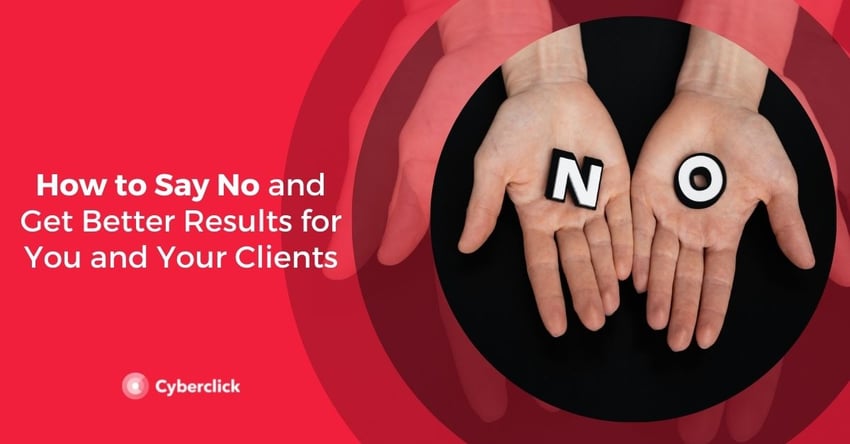In the world of marketing (and in life in general), a timely "no" can be very useful. We are often taught to be complacent and say yes to everything, but the truth is that setting boundaries is healthy and even essential.
A very clear case of all this is when you have to say no to a client. You worry that this may generate a loss of income, but in reality, knowing how to say no not only increases your well-being, but also your profits.

Get Over the Fear of Saying No
To learn how to say no safely and assertively, the first thing you have to get out of your head is that a no is inherently negative. In reality, it is simply a way of conveying a disagreement with an idea or point of view, but it is not an insurmountable barrier or a judgment on the person who you say no to.
Saying no is often perceived as a source of conflict, but it can be the opposite. If you do not say no in time, you may end up making promises that are impossible to keep and generating many more problems in the long run. Therefore, it is much more effective to make the limits clear from the beginning.
However, in order for this to be well received, you must have an alternative ready. For example, explain why you believe there is a better way to do the task in question or why it is not a good time or, if there is a service that you cannot provide to a client, recommend another professional who can help.
Reasons to Say No to a Client
1. The Budget Is Not Sufficient
It's very simple: if you want your company to be profitable, you have to spend your time and resources on projects that are sufficiently profitable.
If you don't know how to say no to clients with a tight budget, you won't generate enough profit and, what's worse, you'll miss out on opportunities that may pay much better.
Sometimes, in times of project scarcity, it is very difficult to pass up opportunities. However, if you take on a project that doesn't pay off, you will always end up losing out. Be clear about what your minimum rates are and be willing to say no to projects that don't meet them.
2. The Customer's Ideas Don't Align with Yours
Sometimes a client is convinced that they want to implement a particular idea for their campaign, but your experience and expertise tells you that it is not going to work.
This is a delicate situation but you have to be clear and you have to advise and guide the client. This includes saying no when necessary.
In the end, what the client needs from you are great results, not for you to just go along with whatever they think is right. If you find yourself in this situation, reframe the issue tactfully and use the tools below to say no in a healthy way.
3. You Do Not Have the Capacity to Take on the Project
It is impossible to be an expert in everything. A marketing professional, or even an agency, specializes in a number of services, but there will be others that it cannot offer with quality guarantees.
In this case, you have to be honest with yourselves and with the client. Sometimes the best option is to outsource or delegate a service. If this does not work out, you can directly recommend another agency or professional.
4. Set Limits on Your Time
Excessive meetings, endless and unproductive WhatsApp conversations, calls outside working hours, etc. are all factors that waste your time and increase staff dissatisfaction.
Before starting a project with a new client, you have to make the expectations in terms of communication very clear. This includes when you will have meetings, the number of reports they can expect, which communication channels you will use, etc. and then you can say no to client requests that are outside of what you agreed on.
5. The Customer's Values Don't Align with Yours
Having clear values is a fundamental key to a happy company. Values guide your work and give you the motivation to do your best every day. It doesn't matter how important a customer is or how big an opportunity is: if it does not aligned with your company's values, it will cause difficulties in the long run.
How to Say No Without Creating Conflict
1. Choose Your Words Carefully
When you say no to a customer, you should offer a well-reasoned argument and be polite but assertive. Do not be tempted to get into an argument; just calmly and clearly tell them what your point of view is.
Your choice of words is very important since an aggressive and negative vocabulary can make the other party feel attacked and cause them to become defensive.
2. Find Another Way to Say No
Sometimes the best way to say no is actually by avoiding the very word itself. Try other ways to set boundaries and offer a different point of view, such as:
-
I understand where you are coming from, but if you allow me, I would like to contribute my point of view.
-
I think it is best to wait a little longer to implement this idea.
-
In this case I would opt for another course of action, but your proposal is definitely interesting so let's reevaluate it next quarter.
3. Suggest Alternatives
No should not be the end of the conversation, but an open door to consider other options to solve the client's need.
For example, if a client proposes weekly Zoom meetings but this doesn't work for you, you can offer a weekly email summary and one in-depth meeting per month. If you believe their proposal will not work well with their target audience, you should present an alternative proposal and explain why it will work better. No does not have to be destructive; on the contrary, it is an opportunity to keep building.
CEO y cofundador de Cyberclick. Cuenta con más de 25 años de experiencia en el mundo online. Es ingeniero y cursó un programa de Entrepreneurship en MIT, Massachusetts Institute of Technology. En 2012 fue nombrado uno de los 20 emprendedores más influyentes en España, menores de 40 años, según la Global Entrepreneurship Week 2012 e IESE. Autor de "La empresa más feliz del mundo" y "Diario de un Millennial".
CEO and co-founder of Cyberclick. David Tomas has more than 25 years of experience in the online world. He is an engineer and completed an Entrepreneurship program at MIT, Massachusetts Institute of Technology. In 2012 he was named one of the 20 most influential entrepreneurs in Spain, under the age of 40, according to Global Entrepreneurship Week 2012 and IESE. Author of "The Happiest Company in the World" and "Diary of a Millennial".






Leave your comment and join the conversation